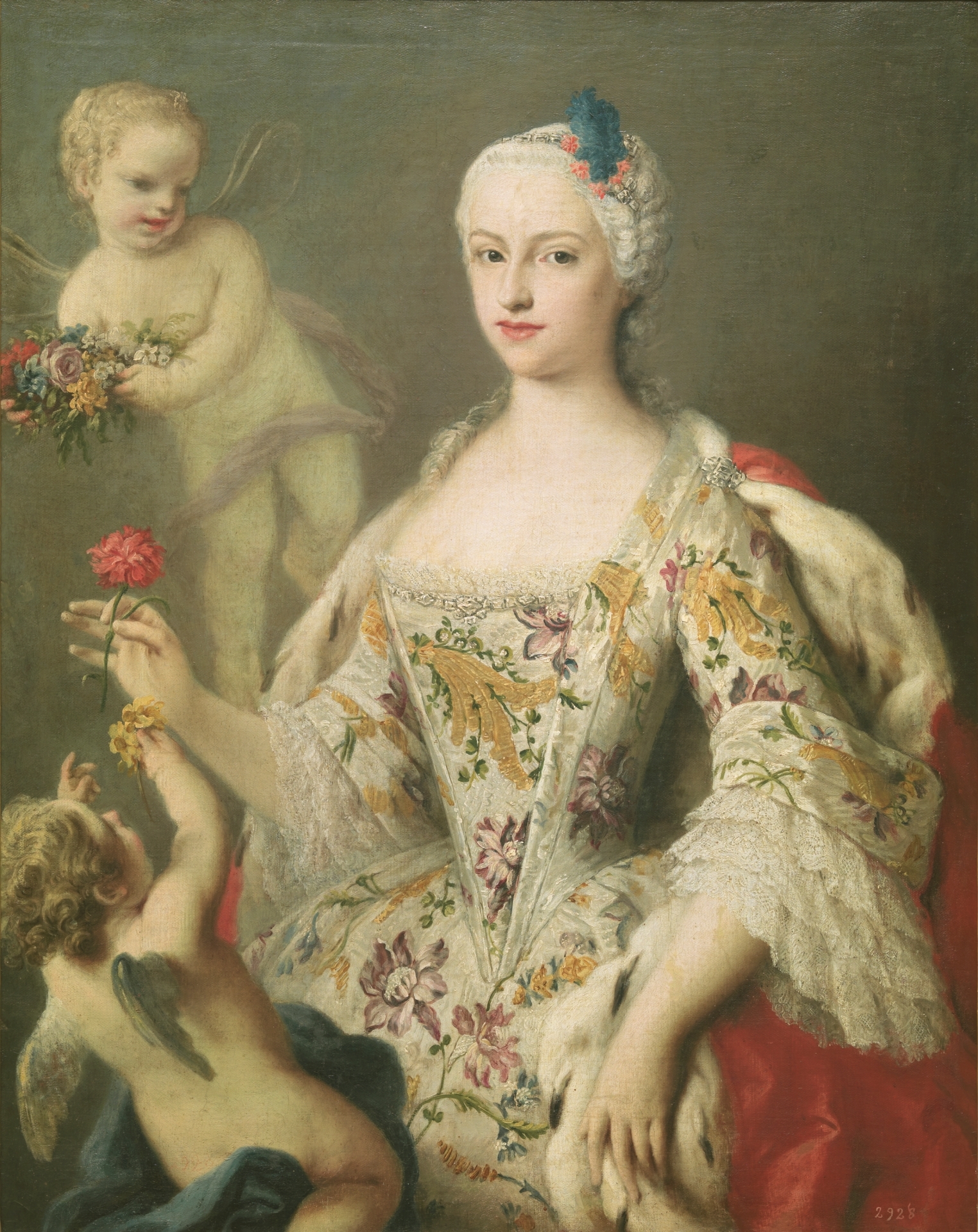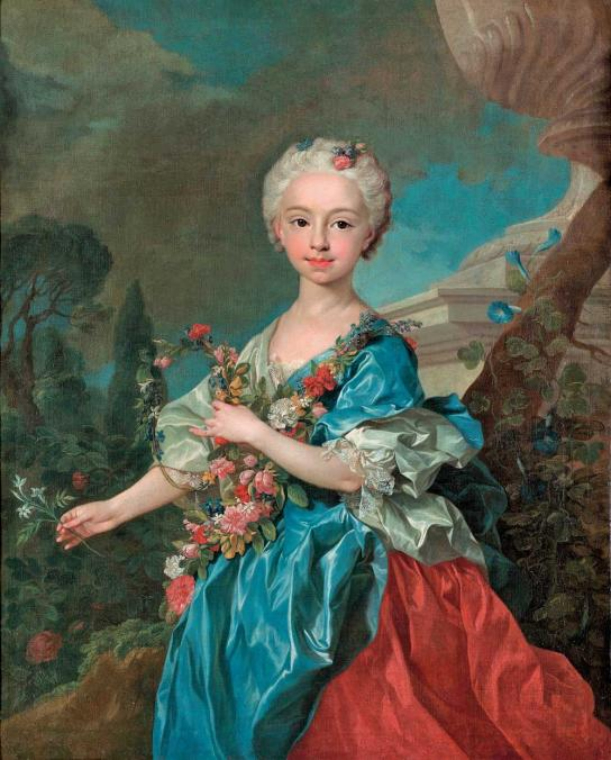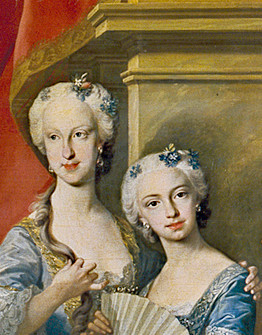1. Overview
Maria Antonia Ferdinanda of Spain, also known as María Antonia Fernanda de BorbónSpanish, born on November 17, 1729, in Seville, Spain, was the youngest daughter of Philip V of Spain and his second wife, Elisabeth Farnese. As an Infanta of Spain, she held the title of Infanta of Spain and the style of Royal Highness. Through her marriage to Victor Amadeus III of Sardinia, she became the Queen of Sardinia in 1773 upon her husband's ascension to the throne.
She played a significant role at the Savoyard court, where she introduced rigid Spanish etiquette. A devoted and somewhat reserved individual, she was known for her profound religious piety. Maria Antonia Ferdinanda was the mother of twelve children, including the last three mainline Kings of Sardinia: Charles Emmanuel IV, Victor Emmanuel I, and Charles Felix. She died on September 19, 1785, at the Castle of Moncalieri and was buried at the Royal Basilica of Superga in Turin.
2. Birth and Family
Maria Antonia Ferdinanda's early life was deeply rooted in the Spanish royal court, marked by her noble lineage and the political context of her birth.

2.1. Early life and education
Maria Antonia Ferdinanda was born on November 17, 1729, at the Royal Alcázar of Seville in Seville, Spain. Her birth coincided with a significant political event: the signing of the Treaty of Seville, which formally ended the Anglo-Spanish War. She spent her infancy in Seville before the family relocated to Madrid in 1733.
She was baptized with the names María Antonia, along with Fernanda in honor of her half-brother, Ferdinand, who was then the heir to the Spanish throne. Throughout her life, variations of her name, such as "Antonia Fernanda" and "Antonietta Ferdinanda," were also used. By birth, as a daughter of the King of Spain, she was granted the title of Infanta of Spain and accorded the style of Royal Highness.


2.2. Marriage negotiations and marriage
Early in her life, Maria Antonia Ferdinanda was part of complex diplomatic marriage plans. An initial double marriage proposal involved her marrying Louis, Dauphin of France, while her brother, Infante Philip, would marry the Dauphin's sister Louise Élisabeth of France. While her mother, Elisabeth Farnese, consented to Philip's union with Louise Élisabeth, she insisted on waiting for Maria Antonia Ferdinanda to reach a more mature age before proceeding with her marriage. During this period, the Electoral Prince of Saxony also sought Maria Antonia's hand in marriage.
Ultimately, Infante Philip married Louise Élisabeth in 1739. Her older sister, Infanta Maria Teresa Rafaela, married the Dauphin in 1745. However, Maria Teresa Rafaela died in 1746, just two weeks after the death of their father, Philip V, following complications from childbirth. Her half-brother, Ferdinand VI, who had recently ascended to the Spanish throne, attempted to arrange a marriage between Maria Antonia Ferdinanda, his only unmarried half-sister, and the widowed Dauphin. However, Louis XV rejected this idea, deeming it "incest" due to the prior marriage between their siblings. Instead, the Dauphin married Maria Josepha of Saxony, who was Maria Antonia's sister-in-law through her brother Charles III's marriage to Maria Josepha's older sister, Maria Amalia.
The ultimate marriage for Maria Antonia Ferdinanda was arranged by her half-brother, Ferdinand VI, with Victor Amadeus, Duke of Savoy, who was the eldest son of Charles Emmanuel III of Sardinia and his late wife, Polyxena of Hesse-Rotenburg. This alliance was intended to strengthen diplomatic relations between the courts of Madrid and Turin, as the two powers had fought on opposing sides during the War of the Austrian Succession, which concluded with the Treaty of Aix-la-Chapelle (1748).
The marriage by proxy took place in Madrid on April 12, 1750. The in-person ceremony was held at Oulx, Piedmont on May 31, 1750. As a wedding gift, the new Duchess of Savoy's apartments at the Royal Palace of Turin were extensively remodelled by the renowned architect Benedetto Alfieri. Maria Antonia Ferdinanda received a substantial dowry of 3.50 M ITL Piedmontese Lires, along with Spanish possessions in Milan. In Italy, she became known as Maria Antonietta FerdinandaItalian. The celebrated composer Baldassare Galuppi even composed operas specifically for her marriage to the Duke of Savoy.
3. Duchess of Savoy
Following her marriage, Maria Antonia Ferdinanda assumed the role of Duchess of Savoy, navigating the intricacies of court life and establishing her presence within the Savoyard royal family.
3.1. Court life and personality
Although the marriage was perceived as unpopular by some at the time, Maria Antonia Ferdinanda and Victor Amadeus maintained a close relationship throughout their lives, enduring until her death. From the time of her marriage until her husband's succession to the throne, she was officially styled as the Duchess of Savoy.
The ducal couple cultivated an environment that welcomed modern thinkers and various politicians. As the leading lady of the land, Maria Antonia Ferdinanda introduced a rigid form of etiquette from her native Spain to the Savoyard court. She was noted for her profound religious devotion and was often described as having a cold and shy personality. During this period, she gave birth to twelve children. Tragically, three of her children died in childhood, while two of her surviving offspring later had issue.
4. Queen of Sardinia
The accession of her husband to the throne marked a new chapter in Maria Antonia Ferdinanda's life, elevating her to the position of Queen consort.
Upon the death of her father-in-law, Charles Emmanuel III of Sardinia, in 1773, her husband succeeded him as Victor Amadeus III of Sardinia. With this change, Maria Antonia Ferdinanda became the Queen of Sardinia. She was the first queen consort of Sardinia in over thirty years, following the death of Elisabeth Therese of Lorraine in 1741.
In 1775, her eldest son, Charles Emmanuel, Prince of Piedmont, married Marie Clotilde of France, who was the sister of Louis XVI of France. Maria Antonia Ferdinanda and her daughter-in-law, Marie Clotilde, formed a very close bond.
5. Issue
Maria Antonia Ferdinanda and Victor Amadeus III had twelve children, many of whom played significant roles in European royal houses:
1. King Charles Emmanuel IV (24 May 1751 - 6 October 1819). He married Marie Clotilde of France in 1773 but had no issue.
2. Princess Maria Elisabetta Carlotta (16 July 1752 - 17 April 1753). She died in infancy.
3. Princess Marie Joséphine of Savoy (2 September 1753 - 13 November 1810). She married Louis XVIII, King of France in 1771 but had no issue.
4. Prince Amadeus Alexander (5 October 1754 - 29 April 1755), Duke of Montferrat. He died in infancy.
5. Princess Maria Theresa (31 January 1756 - 2 June 1805). She married Charles X, King of France in 1773 and had issue.
6. Princess Maria Anna (17 December 1757 - 11 October 1824). She married her half-uncle Prince Benedetto of Savoy in 1775 but had no issue.
7. King Victor Emmanuel I (24 July 1759 - 10 January 1824). He married Archduchess Maria Theresa of Austria-Este in 1789 and had issue.
8. Maria Cristina Ferdinanda of Savoy (21 November 1760 - 19 May 1768). She died in childhood.
9. Prince Maurizio Giuseppe Maria (13 December 1762 - 1 September 1799), Duke of Montferrat. He died unmarried of malaria.
10. Princess Maria Carolina of Savoy (17 January 1764 - 28 December 1782). She married Anthony, Electoral Prince of Saxony in 1781 but had no issue.
11. King Charles Felix (6 April 1765 - 27 April 1831). He married Princess Maria Cristina of Naples and Sicily in 1807 but had no issue.
12. Prince Giuseppe Benedetto Maria Placido (5 October 1766 - 29 October 1802), Count of Asti. He died unmarried of malaria.

6. Ancestors
Maria Antonia Ferdinanda of Spain possessed a rich and extensive royal lineage, connecting her to many of the most prominent ruling houses of Europe.
- Parents:
- Philip V of Spain (1683-1746), King of Spain.
- Elisabeth Farnese (1692-1766), Queen of Spain.
- Paternal Grandparents:
- Louis, Dauphin of France (1661-1711).
- Maria Anna Victoria of Bavaria (1660-1690).
- Maternal Grandparents:
- Odoardo Farnese, Hereditary Prince of Parma (1666-1693).
- Dorothea Sophie of Neuburg (1670-1748).
- Paternal Great-Grandparents:
- Louis XIV of France (1638-1715), King of France.
- Maria Theresa of Austria (1638-1683).
- Ferdinand Maria, Elector of Bavaria (1636-1679).
- Henriette Adelaide of Savoy (1636-1676).
- Maternal Great-Grandparents:
- Ranuccio II Farnese, Duke of Parma (1630-1694).
- Isabella d'Este (1635-1666).
- Philip William, Elector Palatine (1615-1690).
- Elisabeth Amalie of Hesse-Darmstadt (1635-1709).
7. Death
Queen Maria Antonia Ferdinanda died on September 19, 1785, at the Castle of Moncalieri in Piedmont. Her passing occurred eleven years before that of her husband, Victor Amadeus III. She was interred at the Royal Basilica of Superga, the traditional burial place for members of the House of Savoy.
8. Titles and Styles
Maria Antonia Ferdinanda held several distinct royal titles and styles throughout her life:
- 17 November 1729 - 31 May 1750: Her Royal Highness The Infanta Doña María Antonia Fernanda of Spain
- 31 May 1750 - 20 February 1773: Her Royal Highness The Duchess of Savoy
- 20 February 1773 - 19 September 1785: Her Majesty The Queen of Sardinia